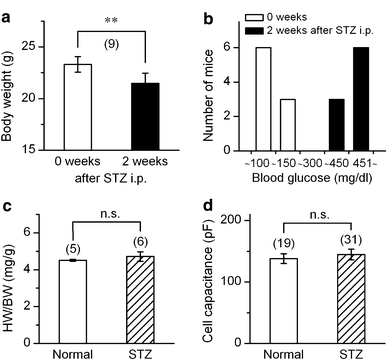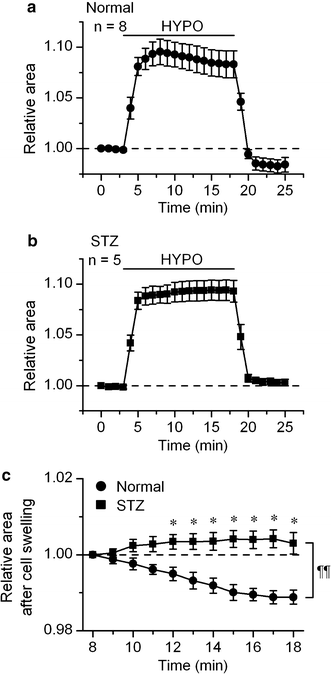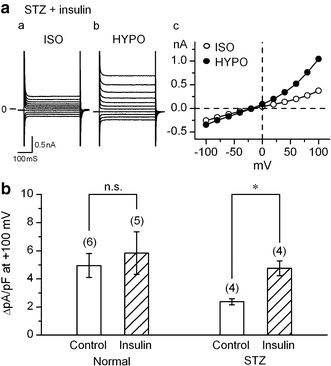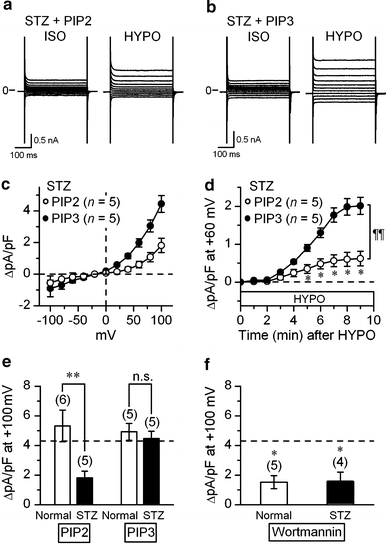Reduced volume-regulated outwardly rectifying anion channel activity in ventricular myocyte of type 1 diabetic mice
- PMID: 19340548
- PMCID: PMC10717248
- DOI: 10.1007/s12576-008-0012-8
Reduced volume-regulated outwardly rectifying anion channel activity in ventricular myocyte of type 1 diabetic mice
Abstract
The currents through the volume-regulated outwardly rectifying anion channel (VRAC) were measured in single ventricular myocytes obtained from streptozotocin (STZ)-induced diabetic mice, using whole-cell voltage-clamp method. In myocytes from STZ-diabetic mice, the density of VRAC current induced by hypotonic perfusion was markedly reduced, compared with that in the cells form normal control mice. Video-image analysis showed that the regulatory volume decrease (RVD), which was seen in normal cells after osmotic swelling, was almost lost in myocytes from STZ-diabetic mice. Some mice were pretreated with 3-O-methylglucose before STZ injection, to prevent the STZ's beta cell toxicity. In the myocytes obtained from such mice, the magnitude of VRAC current and the degree of RVD seen during hypotonic challenge were almost normal. Incubation of the myocytes from STZ-diabetic mice with insulin reversed the attenuation of VRAC current. These findings suggested that the STZ-induced chronic insulin-deficiency was an important causal factor for the attenuation of VRAC current. Intracellular loading of the STZ-diabetic myocytes with phosphatidylinositol 3,4,5-trisphosphate (PIP3), but not phosphatidylinositol 4,5-bisphosphate (PIP2), also reversed the attenuation of VRAC current. Furthermore, treatment of the normal cells with wortmannin, a phosphatidylinositol 3-kinase (PI3K) inhibitor, suppressed the development of VRAC current. We postulate that an impairment PI3K-PIP3 pathway, which may be insulin-dependent, is responsible for the attenuation of VRAC currents in STZ-diabetic myocytes.
Figures






Similar articles
-
alpha-Adrenoceptor-mediated depletion of phosphatidylinositol 4, 5-bisphosphate inhibits activation of volume-regulated anion channels in mouse ventricular myocytes.Br J Pharmacol. 2010 Sep;161(1):193-206. doi: 10.1111/j.1476-5381.2010.00896.x. Br J Pharmacol. 2010. PMID: 20718750 Free PMC article.
-
Regulation of volume-regulated outwardly rectifying anion channels by phosphatidylinositol 3,4,5-trisphosphate in mouse ventricular cells.Biomed Res. 2008 Dec;29(6):307-15. doi: 10.2220/biomedres.29.307. Biomed Res. 2008. PMID: 19129674
-
Volume-sensitive outwardly rectifying chloride channel in white adipocytes from normal and diabetic mice.Am J Physiol Cell Physiol. 2010 Apr;298(4):C900-9. doi: 10.1152/ajpcell.00450.2009. Epub 2010 Jan 27. Am J Physiol Cell Physiol. 2010. PMID: 20107039
-
Biophysics and Physiology of the Volume-Regulated Anion Channel (VRAC)/Volume-Sensitive Outwardly Rectifying Anion Channel (VSOR).Pflugers Arch. 2016 Mar;468(3):371-83. doi: 10.1007/s00424-015-1781-6. Epub 2016 Jan 6. Pflugers Arch. 2016. PMID: 26739710 Review.
-
Physiology of the volume-sensitive/regulatory anion channel VSOR/VRAC: part 2: its activation mechanisms and essential roles in organic signal release.J Physiol Sci. 2024 Jun 14;74(1):34. doi: 10.1186/s12576-024-00926-3. J Physiol Sci. 2024. PMID: 38877402 Free PMC article. Review.
Cited by
-
O-GlcNAcylation Suppresses the Ion Current IClswell by Preventing the Binding of the Protein ICln to α-Integrin.Front Cell Dev Biol. 2020 Nov 19;8:607080. doi: 10.3389/fcell.2020.607080. eCollection 2020. Front Cell Dev Biol. 2020. PMID: 33330510 Free PMC article.
-
alpha-Adrenoceptor-mediated depletion of phosphatidylinositol 4, 5-bisphosphate inhibits activation of volume-regulated anion channels in mouse ventricular myocytes.Br J Pharmacol. 2010 Sep;161(1):193-206. doi: 10.1111/j.1476-5381.2010.00896.x. Br J Pharmacol. 2010. PMID: 20718750 Free PMC article.

